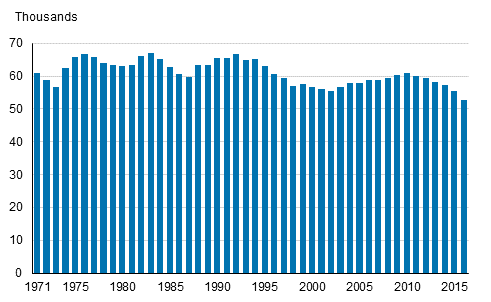Published: 11 April 2017
Fall in the number of births even steeper
According to Statistics Finland's data on population changes, 52,814 children were born in 2016. The number of births has now decreased for the sixth year in succession. The number of births was 2,658 children, i.e. 4.8 per cent fewer than in 2015. This yearly decrease is the highest since the beginning of the 1970s, when measured in relative terms.
Live births 1971–2016

When the number of births is proportioned to women in childbearing age, fertility can be examined. The total fertility rate is commonly used in measuring fertility. It indicates how many children a woman would give birth to calculatorily during her life time if age group-specific fertility rates remained the same as in the year on which the calculation is based.
In addition to the decreasing number of births, the total fertility rate also continued to go down in 2016. At the birth rate prevailing in 2016, a woman would give birth to an average of 1.57 children. The 2015 total fertility rate was 1.65 children per woman. The rate was last lower than 1.57 in 1973, when it was 1.50, an all-time low. Since 1969, the total fertility rate has been below the replacement level, which is 2.1 children per woman.
Compared to the year before, the total fertility rate went down for women under 38, most clearly for those aged 30. In 2016, women who gave birth to their first child were, on average, 29.1 years of age. The average age rose by 0.3 years from the year before and in ten years it has risen by 1.0 years. Correspondingly, the average age of all women that gave birth went up by two decimals from the year before, to 30.8, but over the past ten years it has risen by eight decimals.
Total fertility rate rose only in three regions
The total fertility rate was above the rate for the whole country in 13 regions. Measured with the total fertility rate of 2016, most children would be born in the regions of Ostrobothnia: On average, 2.13 children per woman in Central Ostrobothnia and 1.91 children per woman both in South Ostrobothnia and in North Ostrobothnia. The lowest total fertility rate of 1.45 would be recorded in the region of Uusimaa. The rate was above the replacement level only in Central Ostrobothnia.
Even though the total fertility rate for the whole country declined, the total fertility rates of three regions rose. The rate in the region of Kainuu went up from 1.68 to 1.79 children per woman and in relative terms 6.2 per cent. In Åland, the total fertility rate rose 6.1 per cent and in Central Ostrobothnia 5.8. This rise can be partly explained by the fact that the rates of Central Ostrobothnia and Kainuu in particular had declined steeply in the previous year and have now risen slightly.
Total fertility rate in the region of South Carelia declined from 1.68 to 1.52 children per woman. In relative terms, the figure decreased by 9.6 per cent from the previous year, which was the biggest relative change by region. The birth rate diminished the second most in relative terms in the region of Pohjois-Savo, by 8 per cent. In Pohjois-Savo, the total fertility rate went down from 1.68 to 1.54 children per woman.
Total fertility rate highest in Seinäjoki and lowest in Helsinki
In municipalities with at least 50,000 inhabitants, total fertility rate was highest in Seinäjoki, where it was 1.87 in the five-year period of 2012 to 2016. The second highest rate was found in Oulu, 1.84, the third highest in Porvoo, 1.82, and the fourth highest in Espoo, 1.80. The figure for the whole country in the five-year period was 1.69.
Respectively, the total fertility rate was lowest in the period of 2012 to 2016 in Helsinki, where it was 1.30. The rate was 1.32 in Turku and 1.40 in Tampere. In a comparison of the whole country, the total fertility rate in the last mentioned municipalities was also among the lowest.
Number of live births, total fertility rate and mother's mean age by live births in 2007–2016
| Year | 2007 | 2008 | 2009 | 2010 | 2011 | 2012 | 2013 | 2014 | 2015 | 2016 |
| Number of live births | 58 729 | 59 530 | 60 430 | 60 980 | 59 961 | 59 493 | 58 134 | 57 232 | 55 472 | 52 814 |
| Total fertility rate | 1,83 | 1,85 | 1,86 | 1,87 | 1,83 | 1,80 | 1,75 | 1,71 | 1,65 | 1,57 |
| Mother's mean age by all live births | 30,0 | 30,1 | 30,1 | 30,1 | 30,3 | 30,3 | 30,4 | 30,5 | 30,6 | 30,8 |
| Mother's mean age by first live birth | 28,1 | 28,2 | 28,2 | 28,3 | 28,4 | 28,5 | 28,6 | 28,6 | 28,8 | 29,1 |
Source: Births 2016. Statistics Finland
Inquiries: Marja-Liisa Helminen 029 551 3273, Miina Keski-Petäjä 029 551 3240, info@stat.fi
Director in charge: Jari Tarkoma
Publication in pdf-format (316.1 kB)
- Tables
-
Tables in databases
Pick the data you need into tables, view the data as graphs, or download the data for your use.
Appendix tables
- Figures
-
- Appendix figure 1. Total fertility rate 1900 - 2016 (11.4.2017)
- Appendix figure 2. Age-specific fertility rates 2015 and 2016 (11.4.2017)
- Appendix figure 3. Age-specific fertility rates by birth order 2015 and 2016 (11.4.2017)
- Appendix figure 4. Total fertility rate by municipality for the years 2012 - 2016 (11.4.2017)
- Quality descriptions
-
- Quality description, births 2016 (11.4.2017)
Updated 11.4.2017
Official Statistics of Finland (OSF):
Births [e-publication].
ISSN=1798-2413. 2016. Helsinki: Statistics Finland [referred: 19.4.2025].
Access method: http://stat.fi/til/synt/2016/synt_2016_2017-04-11_tie_001_en.html

